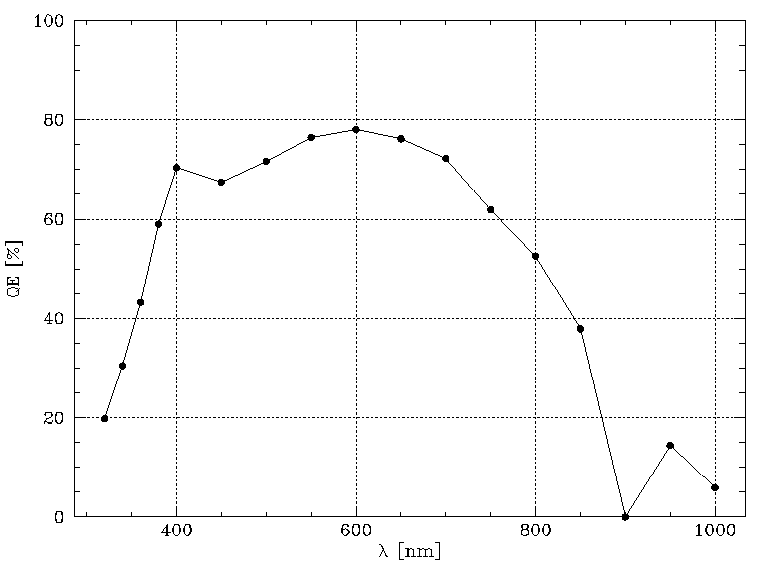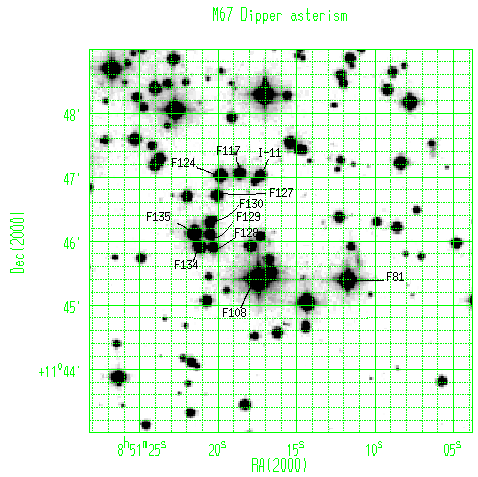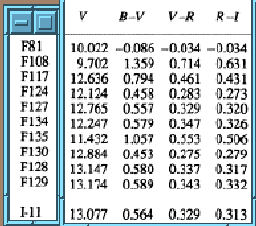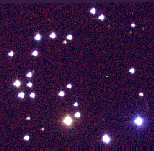 This CCD is also used with the Boller & Chivens Spectrograph.
This CCD is also used with the Boller & Chivens Spectrograph.
The direct imaging camera or Cámara Directa is mounted at the f/12 Cassegrain focus of the telescope, and is equipped with a filter-wheel capable of holding 11 filters at a time. At the image scale of 8.185''/mm, this amounts to approximately 0.20''/pix for the TK1024 CCD as the detector. Considering that the seeing is never better than 1'' at the telescope it is advisable to use the 2x2 or 3x3 or 4x4 binning option available in the PMIS software. This will not only reduce the image size in kbytes (without decreasing the field of view), but also will increase the S/N ratio (readout noise will be less) for the same exposure time.
| Tektronix TK1024 Device Specifications | |
|---|---|
| Format | 1024 X 1024 |
| Pixel size | 24 micron |
| Dark current | 0.4 e-/hour |
| Operating temperature | -110 o C |
| Full Well Capacity | 503,000 e-(at A/D converter limit) |
| Bias Mean level | 1000 ADU at 1X gain |
| Response linearity | 0.1% |
| ADC Resolution | 16 bit |
| Readout rate | 40 kHz |
| Gain/Noise measurements | ||
|---|---|---|
| Software gain | Gain (e-/ADU) | Noise (e- rms) |
| 1X | 7.68 | 8.4 |
| 4X (default) | 1.85 | 3.7 |
A typical quantun efficiency curve for the TK1024 chip is shown below
 This CCD is also used with the Boller & Chivens Spectrograph.
This CCD is also used with the Boller & Chivens Spectrograph.
| Filters details | |||
|---|---|---|---|
| Filter Name |
Central wavelength (Å) |
FWHM (Å) |
Peak Transmission (%) |
| U | 3400 | 600 | 80 |
| B | 4200 | 1100 | 70 |
| V | 5400 | 1200 | 90 |
| R | 6000 | 700 | 70 |
| I | 8500 | 3000 | 100 |
| 656/10 | 6573 | 104 | 100 |
| 662/10 | 6635 | 97 | 100 |
| 668/10 | 6686 | 96 | 100 |
| 674/10 | 6753 | 97 | 100 |
| 680/10 | 6817 | 99 | 100 |
| 686/10 | 6873 | 99 | 100 |
| 373/10 | 3726 | 87 | 100 |
| 378/10 | 3780 | 100 | 100 |
| 385/10 | 3849 | 98 | 100 |
| 391/10 | 3916 | 112 | 100 |
| 397/10 | 3977 | 102 | 100 |
| 500/10 | 5011 | 100 | 100 |
| 506/10 | 5071 | 100 | 100 |
| 512/10 | 5135 | 104 | 100 |
| 518/10 | 5186 | 104 | 83 |
| 524/10 | 5252 | 109 | 83 |
| 530/10 | 5311 | 98 | 81 |
Detailed manual pages on the FILTERWHEEL can be found here.
Any line-free source will do to remove the first of these: either exposures of the large white spots on the side of the dome, or exposures with the twilight sky. For narrow bands, dome flats take too much time to get decent frames.



V - v0 = av + bv(B-V)
U - u0 = au + bu(U-B)
B - b0 = ab + bb(B-V)
R - r0 = ar + br(V-R)
I - i0 = ai + bi(V-I)
where UBVRI are standard magnitudes of Chevalier, C & Ilovaisky, S.A. 1991,
(A& AS, 90, 225) (U from ...). v0, u0, b0,
r0 and i0 are extinction corrected
instrumental magnitudes defined as
v0 = -2.5log10(counts/sec) - kvXv,
where kv and Xv are extinction coefficient and airmass for the V-band image.
a and b are the "zeropoint" and "color coefficient" respectively. Zeropoint is defined as the magnitude that gives 1 count/sec (or equivalently 1.85 e-/sec) in the system for a star of zero color (A0). The derived values of the coefficients are given in the following table:
| Transformation coefficients of the UBVRI filter set | |||
|---|---|---|---|
| Filter | a | b | Eta (%) |
| V | 23.77 | 0.0715 | 14.5 |
| B | 23.24 | -0.1368 | 6.8 |
| R | 22.91 | -0.2859 | 22.6 |
| I | 23.33 | 0.0257 | 8.0 |
| U | 21.04 | ||

 Back to the
Astrophysics Department
Back to the
Astrophysics Department
 Back to the
INAOE Home Page
Back to the
INAOE Home Page
Maintained by Divakara Mayya Last Updated: 08 December 2001